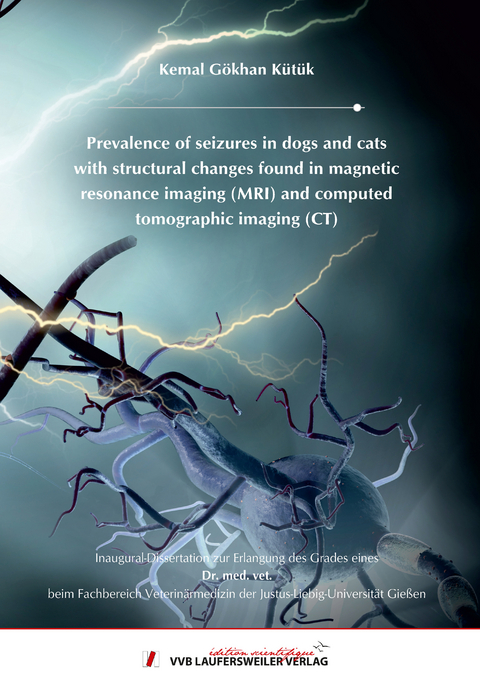
Prevalence of seizures in dogs and cats with structural changes found in magnetic resonance imaging (MRI) and computed tomographic imaging (CT)
Seiten
2018
VVB Laufersweiler Verlag
978-3-8359-6671-0 (ISBN)
VVB Laufersweiler Verlag
978-3-8359-6671-0 (ISBN)
- Keine Verlagsinformationen verfügbar
- Artikel merken
The purpose of this study was to determine a possible association between diagnostic imaging findings and the occurrence of seizures in dogs and cats. We, therefore, retrospectively evaluated the prevalence of seizures in dogs and cats with vascular, inflammatory, infectious, traumatic, anomalous, neoplastic and degenerative lesions of the brain in the course of disease or rehabilitation. Medical records of the Small Animal Surgery Clinics of the Department of Veterinary Clinical Sciences, Justus-Liebig University, Giessen, Germany, were evaluated retrospectively. Groups were built according to general lesion types and according to the VITAMIN D scheme. For each group, patient data including breed, age at the onset of seizures or at the time of referral, seizure type, neurologic examination and diagnostic imaging findings, the clinical and, if available, histo-pathological diagnosis were collected. Assessment of neurologic condition of patients with head trauma was made by means of the Modified Glasgow Coma Scale (MGCS). A time period of at least two years after the discharge of the patient was planned for the evaluation of long-term outcome in animals with head trauma. To obtain information for long-term evaluation, patient owners were interviewed via telephone. According to the lesion groups mentioned the prevalence of seizures related to each lesion type was determined using the formula: prevalence = number of animals with epilepsy/ number of animals per group.
The retrospective search of the database has revealed a total of 346 dogs and 143 cats that were referred either due to epileptic seizures or clinical neurological symptoms that underwent CT or MRI of the neurocranium. Of those, 209 dogs and 86 cats have fulfilled the inclusion criteria and enrolled into the study. In dogs with cerebrovascular accident seizure prevalence was 0.38. None of the cats in this study with suspected vascular cerebral disease had a seizure history. The prevalence of seizures in dogs with infectious CNS inflammation was 0.4 and with non-infectious inflammatory CNS diseases was 0.21. In cats, the prevalence of seizures due to inflammatory CNS diseases was 0.5. In the group of traumatic brain diseases none of the included patients showed epileptic seizure activity. A total of 69 dogs were diagnosed with CNS anomaly and of those 22% were suffering from seizures. Internal hydrocephalus had a prevalence of 13.2 %. In this group were 5 cats were included and only one cat with porencephaly had seizures. The prevalence of seizures in dogs with brain neoplasia was 0.65 and 0.19 in cats. There was only one Dachshund showing MRI changes relating to degenerative disorder of the cerebrum, which was presumed to be cerebral atrophy.
Whereas limited case numbers may not allow to draw conclusions about vascular, neoplastic and degenerative brain disease and epileptic seizures, two main results can be taken from this epidemiological study. It has been stated that seizures are the typical clinical sign found in animals with internal hydrocephalus and in animals with head trauma. As we could not confirm this statement from our source population a reappraisal of these notions and further epidemiological, multicenter studies are necessary to further elucidate the association and underlying pathophysiology of seizures and internal hydrocephalus as well as brain trauma.
The retrospective search of the database has revealed a total of 346 dogs and 143 cats that were referred either due to epileptic seizures or clinical neurological symptoms that underwent CT or MRI of the neurocranium. Of those, 209 dogs and 86 cats have fulfilled the inclusion criteria and enrolled into the study. In dogs with cerebrovascular accident seizure prevalence was 0.38. None of the cats in this study with suspected vascular cerebral disease had a seizure history. The prevalence of seizures in dogs with infectious CNS inflammation was 0.4 and with non-infectious inflammatory CNS diseases was 0.21. In cats, the prevalence of seizures due to inflammatory CNS diseases was 0.5. In the group of traumatic brain diseases none of the included patients showed epileptic seizure activity. A total of 69 dogs were diagnosed with CNS anomaly and of those 22% were suffering from seizures. Internal hydrocephalus had a prevalence of 13.2 %. In this group were 5 cats were included and only one cat with porencephaly had seizures. The prevalence of seizures in dogs with brain neoplasia was 0.65 and 0.19 in cats. There was only one Dachshund showing MRI changes relating to degenerative disorder of the cerebrum, which was presumed to be cerebral atrophy.
Whereas limited case numbers may not allow to draw conclusions about vascular, neoplastic and degenerative brain disease and epileptic seizures, two main results can be taken from this epidemiological study. It has been stated that seizures are the typical clinical sign found in animals with internal hydrocephalus and in animals with head trauma. As we could not confirm this statement from our source population a reappraisal of these notions and further epidemiological, multicenter studies are necessary to further elucidate the association and underlying pathophysiology of seizures and internal hydrocephalus as well as brain trauma.
| Erscheinungsdatum | 07.05.2018 |
|---|---|
| Reihe/Serie | Edition Scientifique |
| Sprache | englisch |
| Maße | 146 x 210 mm |
| Gewicht | 158 g |
| Themenwelt | Veterinärmedizin |
| Schlagworte | Doktorarbeit • Uni • Wissenschaft |
| ISBN-10 | 3-8359-6671-5 / 3835966715 |
| ISBN-13 | 978-3-8359-6671-0 / 9783835966710 |
| Zustand | Neuware |
| Informationen gemäß Produktsicherheitsverordnung (GPSR) | |
| Haben Sie eine Frage zum Produkt? |
Mehr entdecken
aus dem Bereich
aus dem Bereich
Buch | Softcover (2024)
British Small Animal Veterinary Association (Verlag)
70,00 €
A Practical Guide
Buch | Hardcover (2024)
Wiley-Blackwell (Verlag)
145,95 €
Front Office, Operations, and Development
Buch | Softcover (2024)
Churchill Livingstone (Verlag)
94,75 €


